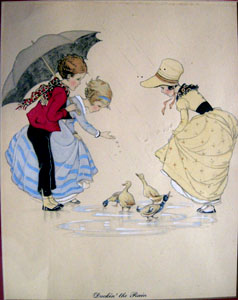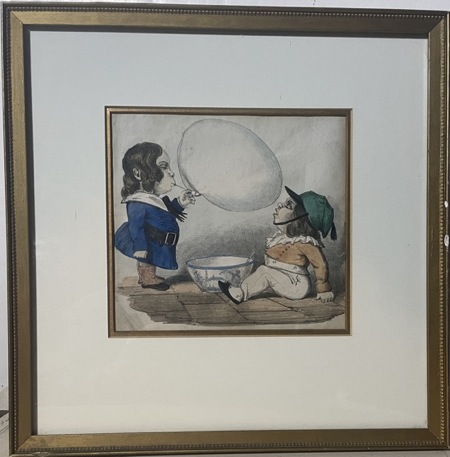

Charles Joseph Staniland
1838-1916
The Cockhorse Regiment - a mediæval episode. 1880
Wood engraving double museum matted, glazed, silver gilt-wood frame.
Size:18 3/4 x 11 1/2" (47.6 x 29.2 cm.) Frame: 17 x 21"
Ref. WO4(185)/SL/ s.ando>DOL PRICE CODE B
Published in The Graphic March 27 1880 Also appeared in as a centerfold engraving in Harper’s Young People an illustrated children's newspaper published in 1880. Depicts a group of young children in Mediæval attire, astride cock horses, playing musical instruments and carring swords, jousting sticks and lances as they march in procession though a European town.
C. J. Staniland 1838-1916 was a prolific and highly respected artist equally at home illustrating children’s novels as he was painting still lifes, historical scenes, seascapes and portraits. He entered the Royal Academy in 1861. A decade later, he had moved to Hogarth Cottage, Chiswick, in 1871, where he was able to afford a monthly nurse for his son Charles and a domestic servant. He was elected an associate of the Royal Institute of Painters in Watercolours in 1875, and a full member in 1879, and a member of the Royal Institute of Oil Painters in 1883. As a painter, he exhibited widely, including at the Royal Academy, the Society of British Artists, the Fine Art Society, the Walker Art Gallery in Liverpool, Birmingham’s Royal Society of Artists, and the Royal Manchester Institution.
As an illustrator, he worked for a wide range of periodicals and book publishers. In 1869 he began a long association with The Graphic, a weekly illustrated newspaper which quickly became famous for the quality of its artwork, and later joined the paper’s staff. As an illustrator of children’s books, he worked in a range of genres – historical fiction (for example illustrating novels by G.A. Henty, W.H.G. Kingston, George Manville Fenn and Harry Collingwood), school stories (novels by Ascott R. Hope), religious works, family and domestic stories, and stories of the sea.
Staniland seems to have retired from painting and illustrating in the early 1900s. At the time of the 1911 census, he was living at 1 Millfield Villas, Fleet, Hampshire, with his daughter Catherine. His wife was living with her daughter Ellen’s family (she had married Charles Cousins, an assurance clerk, in Dulwich. He died five years later, at Acock’s Green, Birmingham, in June 1916, apparently without leaving a will. His wife died in Edmonton, London, in March 1920.




-f.jpg)
-d.jpg)






